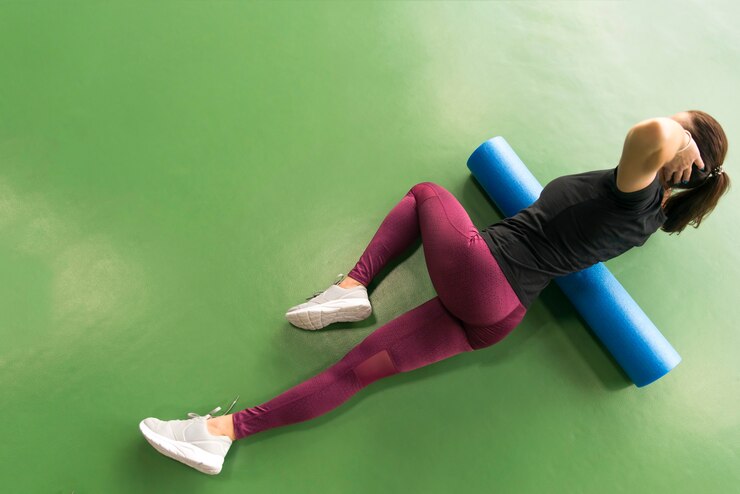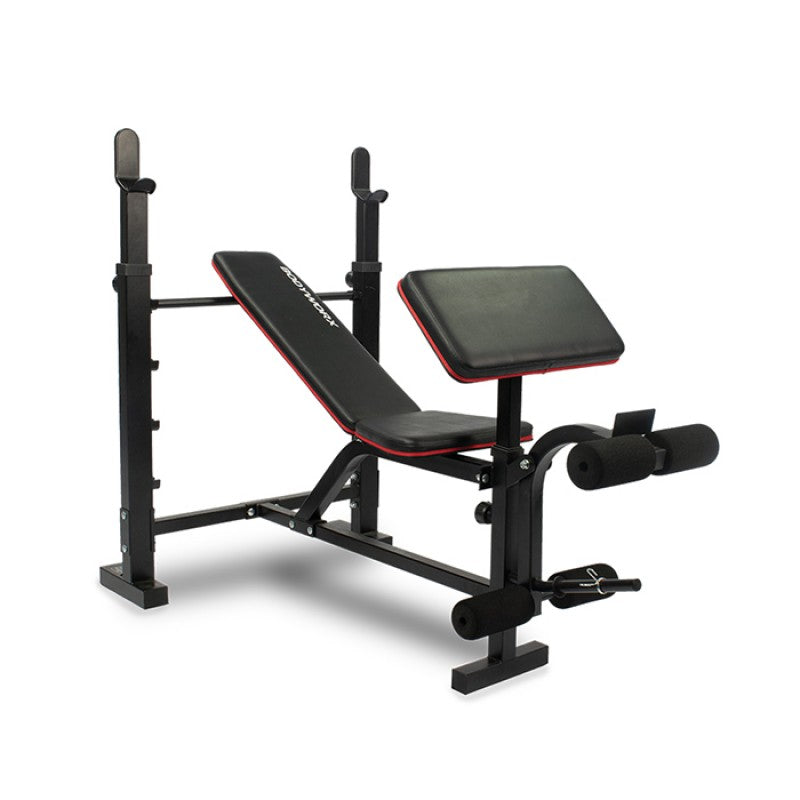
Are you tired of muscle soreness and stiffness?
Do you feel continued pain after your workouts?
Do you wish there was a simple and successful solution to improve your flexibility and overall well-being?
Enters foam rolling!
A game-changer in the area of self-myofascial release (SMR) techniques.
So, ‘What does foam rolling do?’ and ‘How to foam roll?’
In this guide, we’ll learn about the many benefits of foam rolling, along with exercises. From easing muscle pain to managing fibromyalgia symptoms.
Let’s roll into the details!
But before we start, let’s explore a scientific study that will change the way you approach your fitness routine.
Does Foam Rolling Work?
A groundbreaking study with eight male participants was done to understand the after-effects of foam rolling exercises post-workout.
The study showed that combining foam rolling into your after-exercise routine leads to a major reduction in delayed-onset muscle soreness.
Participants who engaged in foam rolling sessions showed not only decreased soreness but also improved physical performance. Compared to those who skipped this technique.
Now, imagine getting these foam rolling benefits for yourself!
6 After-Effects of Foam Rolling
1. Ease Muscle Pain
Foam rolling isn’t just a trend. It’s a science-backed method for easing sore muscles and reducing inflammation. Just 20 minutes of after-exercise foam rolling can help you ease delayed-onset muscle soreness.
Foam Roll Quads Exercise to Ease Muscle Pain
| Position: Sit on the floor with the foam roller beneath your thighs. |
| Execution: Using your hands for support, roll the foam roller up and down from your hips to just above your knees. |
| Pressure: Start with light pressure and gradually increase as your muscles adjust. |
| Duration: Roll each leg for 30 seconds to 1 minute. |

2. Increase Range of Motion & Flexibility
What if you could break free from limited movement?
Research indicates that a combination of foam rolling, and static stretching is a powerful duo. It increases the range of motion.
Imagine a life where your body moves effortlessly. Where flexibility becomes your second nature. Discover how rolling stretching foam will increase your the flexibility needed for peak performance.
Foam Rolling Exercise: Thoracic Spine Opener
| Position: Lie on your back with the rolling foam roller under your upper back. |
| Execution: Support your head with your hands. Allow your upper back to arch over the foam roller. |
| Breathing: Take slow, deep breaths to deepen the stretch. |
| Duration: Hold the position for 30 seconds to 1 minute. |

3. Reduce Cellulite Temporarily: Fact or Fiction?
Cellulite shouldn’t be your constant worry. Let’s debunk the truth behind the claims that foam roll can smooth out cellulite.
According to claims, foam rolling can temporarily smooth out your skin. However, it offers a temporary solution by addressing fascia, the connective tissue responsible for cellulite. But scientific evidence is yet to confirm this.
Apart from the myths and facts. You should confidently embrace your body through an active lifestyle and a healthy diet.
Foam Rolling Exercise: Glute Roll
| Position: Sit on the foam roller with one ankle crossed over the opposite knee. |
| Execution: Lean slightly towards the crossed leg, rolling over one side of the glutes. |
| Focus: Target sensitive areas and knots. |
| Duration: Roll each side for 1-2 minutes. |

4. Relieve Back Pain
Back pain is tough. Foam rolling comes to the rescue in such a situation. Imagine the tension in your lower back melting away as you gently roll away on the foam roller. Feeling relief and improved well-being.
But here’s the thing!
You need to be careful when foam rolling back. Use it right or it might not work as well. Caution is advised. Improper use can lead to further strain.
Foam Rolling Exercise for Lower Back Release
| Position: Lie on your back with the foam roller under your lower back. |
| Execution: Roll gently from side to side, focusing on the muscles adjacent to the spine. |
| Caution: Avoid rolling directly on the spine to prevent injury. |
| Duration: Foam roll lower back for 2-3 minutes. |

5. Cope with Fibromyalgia Symptoms
In a promising study, individuals living with fibromyalgia reported feeling better, after using foam rolling into their routine. It reduced pain intensity, fatigue, stiffness, and depression.
The symptoms of fibromyalgia become more manageable. And the individual range of motion expanded.
Full Body Relaxation with Foam Rolling
| Position: Lie on the foam roller lengthwise, supporting your head and tailbone. |
| Execution: Allow your body to relax over the roller, targeting various muscle groups. |
| Breathing: Practice deep, rhythmic breathing to enhance relaxation. |
| Duration: Enjoy this full-body relaxation for 5-10 minutes. |
6. Relax & Unwind with Foam Rolling
Is foam rolling your ticket to relaxation?
A fantastic YES!
Imagine after workout ease where tightness melts away. Leaving you feeling less tense and more serene. Add it to your weekly routine to enjoy its stress-relieving properties.
Post-Workout Cool Down Foam Rolling Exercise
| Position: Sit or lie down with the foam roller beneath targeted muscle groups. |
| Execution: Roll gently over muscles, focusing on areas of tightness. |
| Mindfulness: Reflect on your workout and allow your body to unwind. |
| Duration: Incorporate this into your cool-down routine for 10 minutes. |

Is Foam Rolling Safe?
Foam rolling can be a safe and effective practice if done correctly. Before you start foam rolling. It’s crucial to understand the safety aspects.
| Always consult with your doctor before using new tools in your routine. |
Discover the do’s and don’ts.
Follow these simple guidelines to enjoy the benefits of foam roll without risking injury.
Do’s of Foam Rolling
| Consult with Your Doctor: Make sure it’s safe for your specific health condition. |
| Start Gradually: Start with light pressure and increase as your muscles adjust. |
| Roll After Exercise: Add foam rolling into your after-workout routine for maximum benefits. |
| Hydrate: Drink plenty of water to aid in muscle recovery. |
| Listen to Your Body: Pay attention to any discomfort you feel and adjust pressure accordingly. |
Don’ts of Foam Rolling
| Avoid High Pressure Initially: If you’re new to foam rolling. Start with gentler pressure to prevent too much soreness. |
| Skip Small Joints: Avoid rolling directly over knees, elbows, and ankles to prevent injury. |
| No Foam Rolling on Serious Injuries: If you have a muscle tear or break refrain from foam rolling without clearance from your doctor. |
| Caution During Pregnancy: If pregnant get clearance from your doctor and avoid lying on your back during later stages. |
| Be Gentle on the Back: When rolling the lower back go vertical instead of horizontal to prevent straining. |
Remember, safety first! If in doubt, consult a professional or your doctor before adding foam rolling to your routine.
How to Choose the Perfect Foam Roller | 7 Tips
Not all foam rollers are created equal. From smooth rollers to textured ones, we’ll guide you through all the options. Helping you find the perfect match for your needs.
Plus, learn tips on size, shape, and portability for the ultimate foam rolling experience.

Density
Get a soft, low-density roll up foam mattress if you’re new to foam rolling or have sensitivity.
Choose a firm, high-density foam roller for more pressure and a deeper massage.
Texture
Smooth foam rollers are best for beginners, providing an even surface and a gentler massage.
Textured foam rollers with ridges or knobs work deeper into muscles, targeting knots and tension.
Size and Shape
Shorter rollers are effective for smaller areas like arms and calves.
Longer rollers better target larger muscle groups like the back and thighs. Ideal for full-body coverage.
Explore Special Features
Vibrating foam rollers offer settings for deep muscle relaxation and enhanced circulation.
Heat and cold foam rollers can be heated or cooled to deepen muscle relaxation and relieve discomfort.
Portability is Key
Pick a compact-size foam roller. Such a roller will easily fit into your gym bag along with your foam roll mat for on-the-go relief.
Multi-Texture Rollers
Choose a roll of foam with both smooth and textured surfaces for a useful massage experience.
Try Before You Buy
Test different foam rollers in-store, if possible, to test comfort and firmness.
Consider online reviews for insights into user experiences with specific brands or models.
Say Goodbye to Sore Muscles
As we wrap up this guide, remember that the power of foam rolling lies in consistency.
Whether you’re a fitness enthusiast or someone dealing with constant aches. Foam rolling is the missing piece in your wellness puzzle. Be safe and enjoy the journey to a healthier, more flexible you.
Get Started
New to foam rolling?
Fear not!
If you prefer online shopping for fitness professional equipment. We’ve got you covered. Explore all kinds of foam rollers at Trojan Fitness.
Kickstart your journey to a more flexible, pain-free you.
Ready to Roll?
If you’re ready to get the benefits of foam rolling.
Take the first step now.
Click the button below to explore a curated selection of foam rollers. Start your journey to a pain-free, more flexible lifestyle.
Buy Easy-to-Carry Foam Rollers Now
Disclaimer:
The information provided on this website is intended for general informational purposes only and should not be considered professional or medical advice. We make every effort to ensure the information provided is accurate and up-to-date, but we cannot guarantee the accuracy, completeness, or timeliness of the information. Any reliance you place on such information is strictly at your own risk. Always consult a qualified professional before making any significant changes to your diet, exercise routine, or lifestyle. We are not responsible for any adverse consequences resulting from the use of, or reliance on, any information provided on this website.
 All Payment Methods are Accepted
All Payment Methods are Accepted









